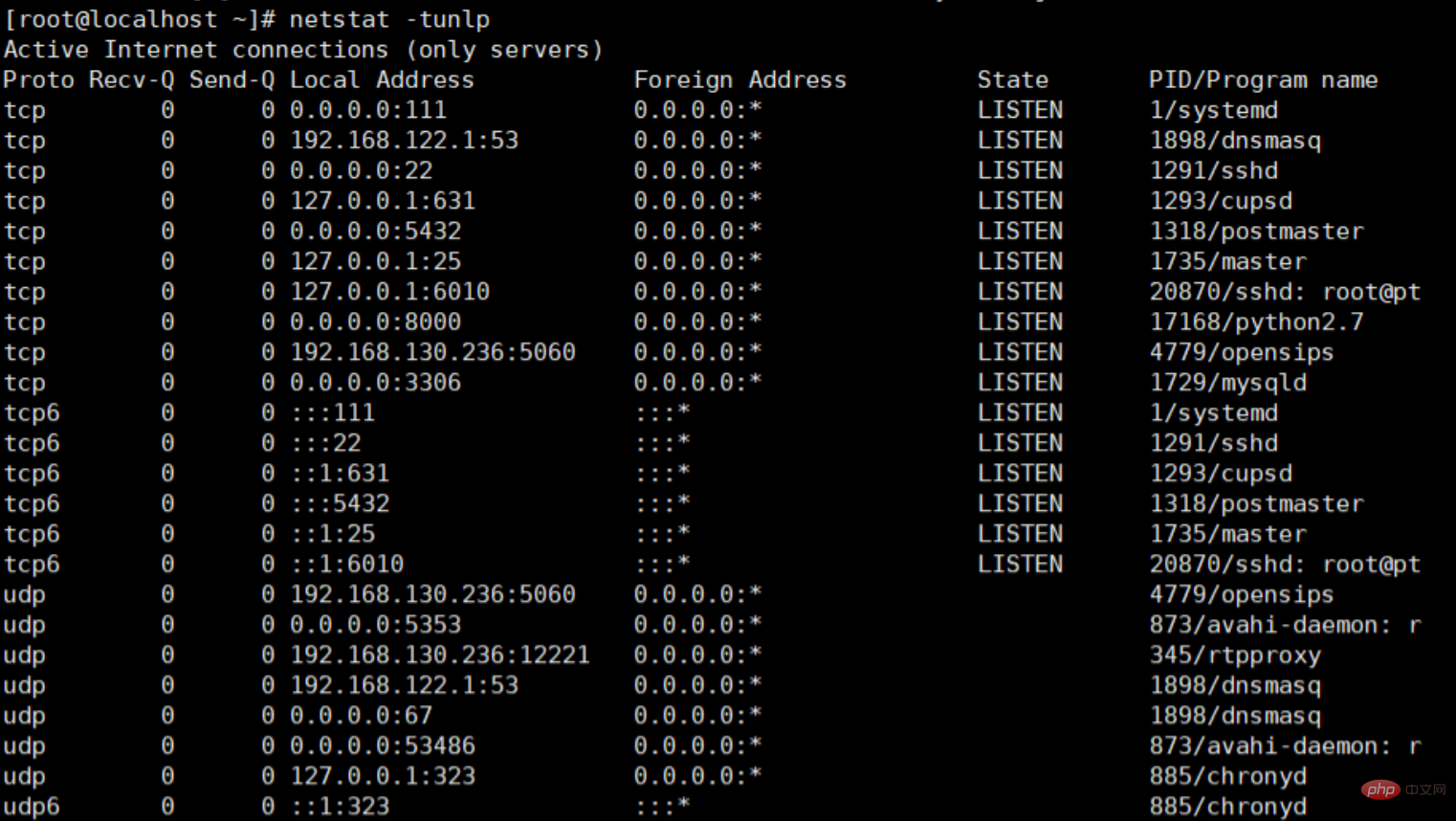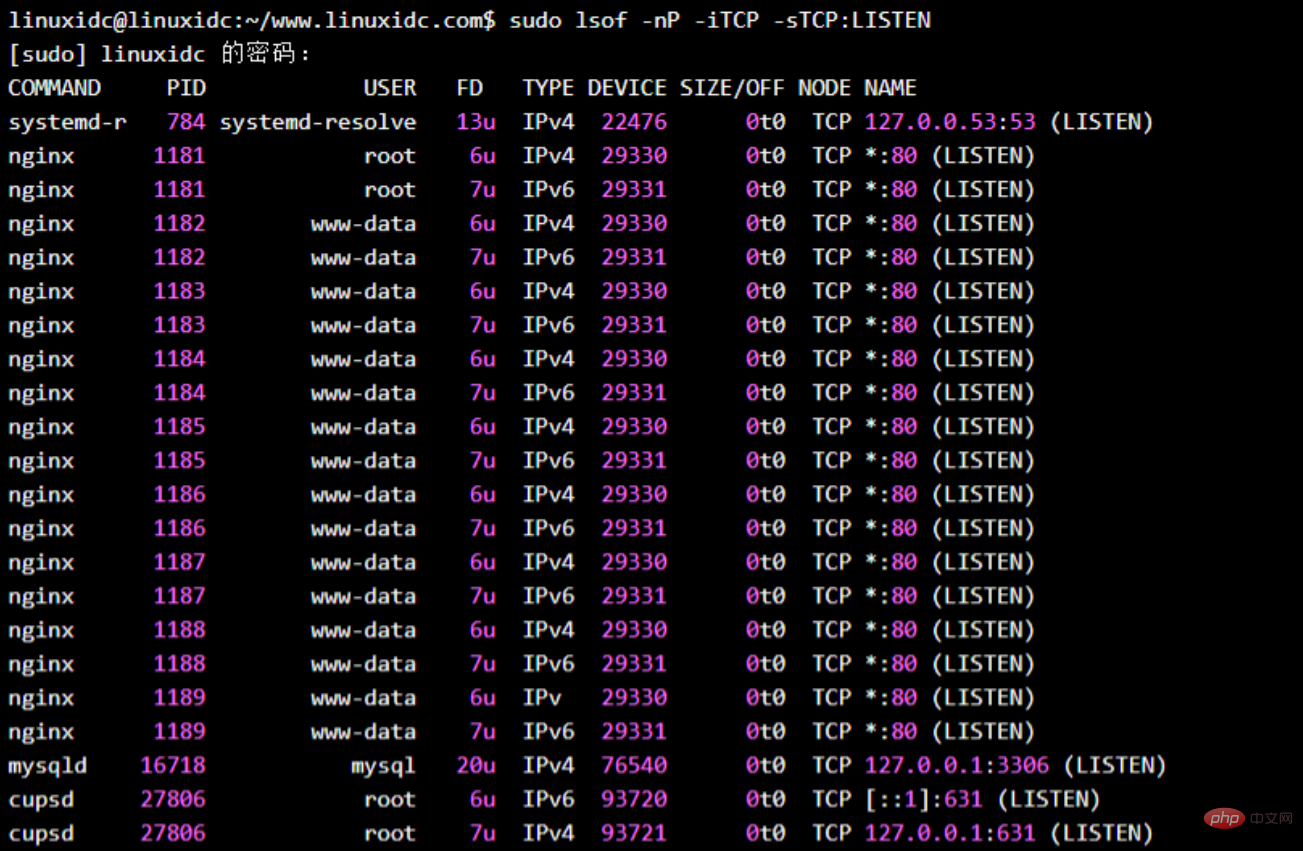How to query the port in linux
Linux query port method: 1. Use the netstat command, the syntax is "netstat [-acCeFghilMnNoprstuvVwx][-A
][--ip]"; 2. Use the ss command to display details TCP and connection status information; 3. Use the lsof command.

The operating environment of this tutorial: linux5.9.8 system, Dell G3 computer.
linux query port
1. Use netstat to check the port
netstat is a command line Tool that provides information about network connections.
To display all open ports, please use the following command: netstat -anp
To list all TCP or UDP ports that are listening, including the used port and socket To access the service, use the following command: netstat -tunlp
The options used in this command have the following meanings:
-t – Display the TCP port. -u – Display UDP ports. -n – Display numeric addresses instead of hostnames. -l – Show only listening ports. -p – Displays the PID and name of the process. This information is only displayed if you run the command as root or sudo user.
Query the specified port through grep filtering: netstat -tnlp | grep :80
Display example:

Note: Proto – the protocol used by the socket. Local Address – The IP address and port number the process listens on. PID/Program name – PID and process name.
2. Use ss to check the port
ss is the new netstat, and the command options are roughly the same. It lacks some netstat functionality, but exposes more TCP status and is slightly faster.
Usage example: ss -tunlp

3. Use lsof to check the port
lsof is a powerful function A command-line utility that provides information about files opened by a process.
In Linux, everything is a file, and sockets can be thought of as files written to the network.
To use lsof to get a list of all listening TCP ports: lsof -nP -iTCP -sTCP:LISTEN
The options used are the following: -n – Do not convert port numbers to port names. -p – Do not resolve hostnames, display numeric addresses. -iTCP -sTCP:LISTEN – Display only network files with TCP protocol status LISTEN.
Usage Example:

To find processes that are listening on a specific port (such as 3306), use the following command: sudo lsof -nP -iTCP: 3306 -sTCP:LISTEN
Related recommendations: "Linux Video Tutorial"
The above is the detailed content of How to query the port in linux. For more information, please follow other related articles on the PHP Chinese website!

Hot AI Tools

Undresser.AI Undress
AI-powered app for creating realistic nude photos

AI Clothes Remover
Online AI tool for removing clothes from photos.

Undress AI Tool
Undress images for free

Clothoff.io
AI clothes remover

Video Face Swap
Swap faces in any video effortlessly with our completely free AI face swap tool!

Hot Article

Hot Tools

Notepad++7.3.1
Easy-to-use and free code editor

SublimeText3 Chinese version
Chinese version, very easy to use

Zend Studio 13.0.1
Powerful PHP integrated development environment

Dreamweaver CS6
Visual web development tools

SublimeText3 Mac version
God-level code editing software (SublimeText3)

Hot Topics
 1670
1670
 14
14
 1428
1428
 52
52
 1329
1329
 25
25
 1274
1274
 29
29
 1256
1256
 24
24
 Linux Architecture: Unveiling the 5 Basic Components
Apr 20, 2025 am 12:04 AM
Linux Architecture: Unveiling the 5 Basic Components
Apr 20, 2025 am 12:04 AM
The five basic components of the Linux system are: 1. Kernel, 2. System library, 3. System utilities, 4. Graphical user interface, 5. Applications. The kernel manages hardware resources, the system library provides precompiled functions, system utilities are used for system management, the GUI provides visual interaction, and applications use these components to implement functions.
 vscode Previous Next Shortcut Key
Apr 15, 2025 pm 10:51 PM
vscode Previous Next Shortcut Key
Apr 15, 2025 pm 10:51 PM
VS Code One-step/Next step shortcut key usage: One-step (backward): Windows/Linux: Ctrl ←; macOS: Cmd ←Next step (forward): Windows/Linux: Ctrl →; macOS: Cmd →
 How to check the warehouse address of git
Apr 17, 2025 pm 01:54 PM
How to check the warehouse address of git
Apr 17, 2025 pm 01:54 PM
To view the Git repository address, perform the following steps: 1. Open the command line and navigate to the repository directory; 2. Run the "git remote -v" command; 3. View the repository name in the output and its corresponding address.
 How to run java code in notepad
Apr 16, 2025 pm 07:39 PM
How to run java code in notepad
Apr 16, 2025 pm 07:39 PM
Although Notepad cannot run Java code directly, it can be achieved by using other tools: using the command line compiler (javac) to generate a bytecode file (filename.class). Use the Java interpreter (java) to interpret bytecode, execute the code, and output the result.
 How to run sublime after writing the code
Apr 16, 2025 am 08:51 AM
How to run sublime after writing the code
Apr 16, 2025 am 08:51 AM
There are six ways to run code in Sublime: through hotkeys, menus, build systems, command lines, set default build systems, and custom build commands, and run individual files/projects by right-clicking on projects/files. The build system availability depends on the installation of Sublime Text.
 What is the main purpose of Linux?
Apr 16, 2025 am 12:19 AM
What is the main purpose of Linux?
Apr 16, 2025 am 12:19 AM
The main uses of Linux include: 1. Server operating system, 2. Embedded system, 3. Desktop operating system, 4. Development and testing environment. Linux excels in these areas, providing stability, security and efficient development tools.
 laravel installation code
Apr 18, 2025 pm 12:30 PM
laravel installation code
Apr 18, 2025 pm 12:30 PM
To install Laravel, follow these steps in sequence: Install Composer (for macOS/Linux and Windows) Install Laravel Installer Create a new project Start Service Access Application (URL: http://127.0.0.1:8000) Set up the database connection (if required)
 git software installation
Apr 17, 2025 am 11:57 AM
git software installation
Apr 17, 2025 am 11:57 AM
Installing Git software includes the following steps: Download the installation package and run the installation package to verify the installation configuration Git installation Git Bash (Windows only)




